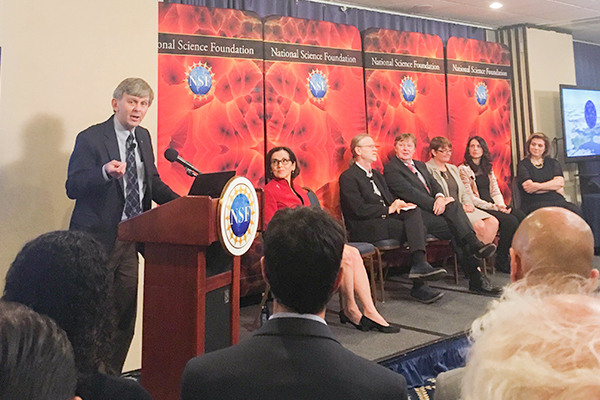Once Again, LIGO Makes History
Winter
2018
Special Feature
Once Again, LIGO Makes History
Maya Kinley-Hanlon, SPS Member, American University
This summer, LIGO once again made history. The Laser Interferometer Gravitational Wave Observatory saw signals from two neutron stars colliding, the morning of August 17, 2017. As a student reporter for The SPS Observer, I got to attend the official announcement of the discovery on October 16th.
It was thrilling to be in the same room as 30 journalists from such a wide array of publications. I was sitting next to a reporter from the LA Times. None of us, at the time, knew what would be announced, simply that it was a discovery that would rock the astronomical community. Suddenly, a hush came over the room as the panelists silently filed in. After the introductions were made, France Córdova, Director of the National Science Foundation (NSF), took the podium. “Today,” she said, “we are thrilled to announce that scientists have detected gravitational waves coming from the collision of two neutron stars.”
David Reitze, executive director of the LIGO lab at Caltech, then took the podium. “We have, for the first time, seen both gravitational waves and light from the collision of two dense, dense, stars,” he said. “This time…we all did it.” It is that message that resonated as each panelist spoke. What was possibly the most amazing feat of this discovery is not just its impact, but also the fact that it was a collaboration between LIGO, VIRGO, and over 70 astronomical observatories in the world, with both ground- and space-based detectors. 
LIGO deputy spokesperson Laura Cadonati mentioned that nature has been benevolent with LIGO throughout the entire process. The strong initial signal of two black holes merging was a clear announcement to the world that the science of LIGO was successful. And while the detection of a binary neutron star merger was an expected detection, it announced a revolutionary new era of multi-messenger astronomy. The binary neutron star merger was the first to be seen and gave a description for the amount of gold and platinum that exists in the universe. Additionally, because neutron stars are so dense, their collision is bright and able to be seen by not only gravitational wave detectors, but by telescopes around the world, including gamma-ray and x-ray detectors. Being able to study this event by looking at gravitational waves and light together will allow astronomers to learn even more about our universe.
The LIGO Collaboration has grown up over the past 40 years, along with the researchers who have dedicated their lives to it. Until the initial discovery of gravitational waves in 2015, LIGO efforts were hardly known by the public and viewed with skepticism by more established astronomy communities. The researchers of LIGO pushed on, not because they hoped to gain fame, but because they believed in what they were doing. This made the collaboration one of community and support, which was clearly evident during the press conference. Every scientist on the LIGO panel echoed each other that this most recent discovery was one made and celebrated by a community.
After a celebratory dinner, I sat with astronomer and researcher Vicky Kalogera and Laura Cadonati, talking about the importance of such a large collaboration. Kalogera, who came from a pure astronomy background, talked about how before she joined LIGO she was used to very small groups, and she grew to understand that you cannot achieve results like these without a collaboration of this size. “No individual group can reach this kind of achievement,” she said. “We need each other.”
Towards the end of dinner, Cadonati and LIGO spokesperson David Shoemaker were pushed to give a toast. “This is a celebration of a remarkable result of observations of LIGO, and a really joyous combination of both this collaboration and our electromagnetic partners that has turned out remarkably well,” Shoemaker said.
Cadonati added, “We want to thank you for this amazing endeavor…It has not always been easy, but the very fact that we got 3500 authors on the same paper, 70 papers in the archives today, and we took down the journal web servers,” she said to cheers and applause from the room, “is an amazing accomplishment. I look forward to all of you giving talks to the general public and raising enthusiasm for gravitational wave astrophysics, gravitational wave cosmology, gravitational wave nuclear physics, and the good things that will come. Thank you everyone, and welcome to the new era.” With that, the room erupted into thunderous applause.
What keeps LIGO researchers going is the hunt for more discovery. Kalogera put it simply: “No matter what, research is about questions.” This is what we can all keep in mind as we find the efforts we want to dedicate our lives to. I’m thankful to have begun my career in research within the LIGO Collaboration. Hopefully, no matter what we choose to study, we are surrounded by as much support and joy as LIGO has had. //
